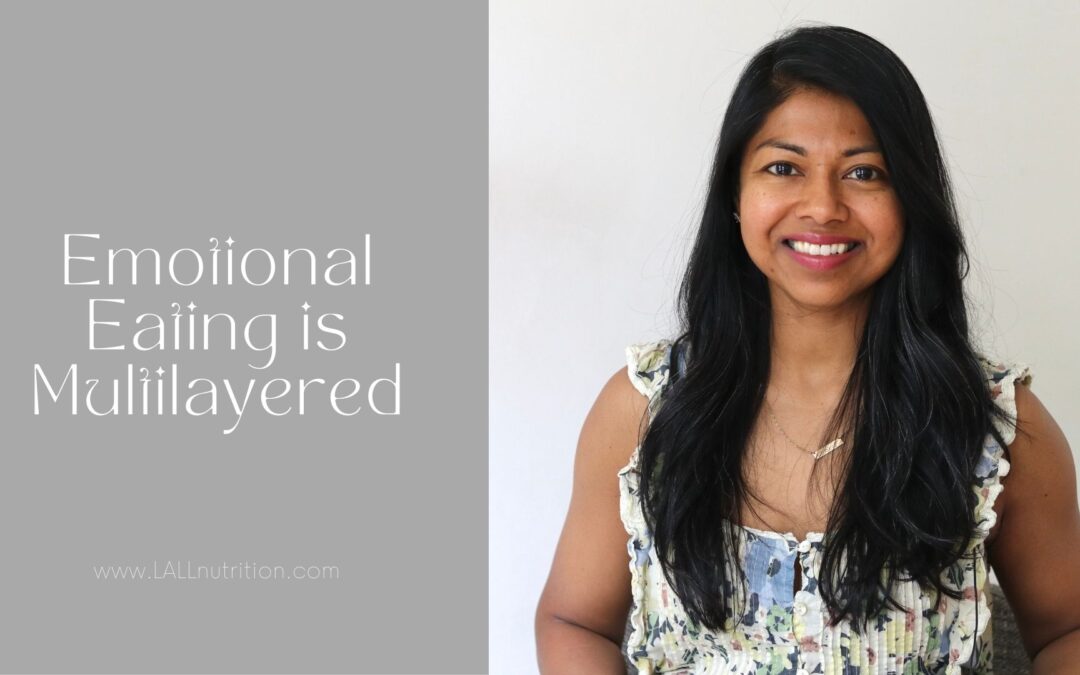Hello love,
I thought I would cover this because emotional eating is multilayered, it has a lot of different facets to it.
However what we are sold for emotional eating is really something simple and it’s on the surface. We think if we do this one thing, we’re going to figure out our emotional eating. In a way that’s good because it motivates us, it gives us something to hook onto, to move towards.
But if we keep trying those surface solutions, we don’t get very far. We need to expand what we know about emotional eating.
Emotional eating is a coping mechanism, which means that we developed it in order to deal with any distress, discomfort or uncomfortable emotions in our life. This is a pattern that would have been developing for a long time, from our childhood onwards.
It might have shifted forms, but it is still the same pattern. And it’s when we use food to soothe or numb ourselves or distract from this discomfort because it’s uncomfortable (duh!). Part of the reason is that we don’t know what to do with this discomfort. We don’t know how to get rid of it, we don’t know how to resolve it. So the next best thing we can do to survive is to cope with it.
Of course, as children, we don’t have a lot of tools and if we don’t have parents or caregivers there to guide us through this process then you would have been lost. As a little human this is the capacity we had to survive. We try to figure out how to survive and we piece together things in our environment.
Our parents might have also been emotional eaters. They might have coped with their own emotions or had addictions. All of these things are happening to create this coping mechanism.
We might be aware we have emotions or mood changes and we don’t know what to do with them. We don’t know how to resolve them.
Consciously vs. Unconsciously
We can emotionally eat consciously. So we know we’re sad, we’re going to go eat the thing. I had a rough day, I’m going to go have some food. We reward ourselves with it. Or unconsciously, where we’re thrown into an emotional eating episode.
This pattern has different layers and what I see with clients is we can be triggered into our emotional eating whenever any discomfort mood imbalance happens.
Food
This discomfort can be around food. If we have a restrictive mindset around food and/or we’re not nourishing our bodies.
We can have this pattern arise around the food choices we’re making. So whether we are choosing foods out of our emotional eating pattern or we’re choosing foods because we don’t know how to truly nourish our body, this can trigger mood imbalance and trigger us into emotional eating.
Body
We can have discomfort around our body. Are we honoring our body’s rhythms and rituals? Are we accepting it? Or are we saying something’s wrong with us and going into the shame spiral and trying to control our bodies. This can trigger emotional eating if we have this underlying way of coping with life.
Emotions
If we distract from our emotions this triggers emotional eating. Obviously, for emotional eaters, we’re using food and not looking at the deeper root of what happened. Without going deeper we are not able to truly meet those deep needs and resolve this pattern.
These are the three areas that we can be triggered into emotional eating. Only when we’re triggered with actual emotions, unresolved events (traumas) from the past is it what I would consider true emotional eating, because then it is about our deeper emotions and this deeper level of trauma.
The other two areas, they can add into this deeper emotional layer, especially if we have deep shame around our body. Or we rarely critical of ourselves when we do something wrong and we’re not making the right food choice.
Managing is not the same as resolution
That’s why when you switch your diet and you will power through, you might notice some of your emotional eating dissipates. Or if you are at the gym and you’re working out and you’re feeling good, that shame is not triggered about your body because you’re fitting into the box you think you should.
But when you slip, you’re back in the shame spiral and then what usually happens is we don’t really ever attain that body or it’s very short lived because then we’re building our self worth on a shaky foundation.
So in a way, the first two levels around food and body, we can shift them. That’s what’s marketed to us. Change the way you eat, go to the gym. We’re just managing these beliefs by doing these activities.
It’s not because it’s coming from a core place of genuinely wanting to take care of yourself. “I want to nourish myself, I want to take care of my body, I want to have great health”. We might be saying those things to ourselves, but the deeper belief we have is that “I’m not acceptable as I am and I need to look a certain way. So it doesn’t matter if I’m really healthy, that healthy has to look a certain way.” Which is a limiting belief.
It’s not built on the solid foundation of I am worthy of having a healthy body.
If we haven’t dealt with that deeper core level, that unresolved trauma and limit is like putting ice cream on top of poop.
Emotional Eating is Multilayered
And that’s why emotional eating is so multilayered. What I want you to take from this is that there are deeper root issues going on. It doesn’t matter how much you willpower if you don’t get to those core root issues, you struggle with them. I’ve worked with people who are very holistic but they haven’t dealt with this deeper trauma to really fully realize that desire and to come from that true place. It’s like you’re moving forward with this anchor holding you back.
This is what we do inside of The Emotional Eating Evolution Program, it’s about you connecting back to you and understanding your patterns and how you have been coping and shifting it at the root level. If you’re curious about The Emotional Eating Evolution Program, you can find out more about it HERE. It is a 12 week container. There’s a step by step methodology, weekly support + accountability, community and in depth somatic meditations to get to the root so that you can finally resolve this pattern and start feeling confident in your body and around food.
~Michelle
Certified Holistic Nutritionist Specializing in Emotional Eating


